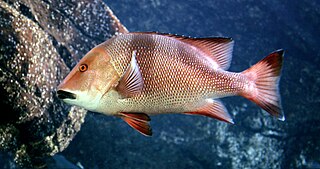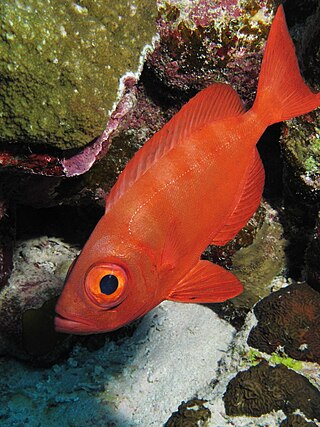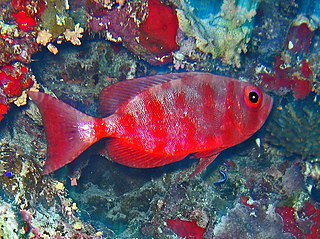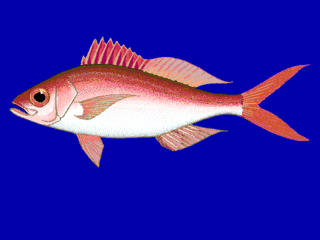
The northern red snapper is a species of marine ray-finned fish, a snapper belonging to the family Lutjanidae. It is native to the western Atlantic Ocean, the Caribbean Sea, and the Gulf of Mexico, where it inhabits environments associated with reefs. This species is commercially important and is also sought-after as a game fish.

The Priacanthidae, the bigeyes, are a family of 18 species of marine ray-finned fishes. "Catalufa" is an alternate common name for some members of the Priacanthidae. The etymology of the scientific name refers to the family's very rough, spined scales. The common name of "bigeye" refers to the member species' unusually large eyes, suited to their carnivorous and nocturnal lifestyles. Priacanthidae are typically colored bright red, but some have patterns in silver, dusky brown, or black. Most species reach a maximum total length of about 30 cm (12 in), although in a few species lengths of over 50 cm (20 in) are known.

The lane snapper, the Mexican snapper, redtail snapper or spot snapper, is a species of marine ray-finned fish, a snapper belonging to the family Lutjanidae. It is native to the western Atlantic Ocean.

The mangrove red snapper, also known as mangrove jack, grey snapper, creek red bream, Stuart evader, dog bream, purple sea perch, red bream, red perch, red reef bream, river roman, or rock barramundi, is a species of marine ray-finned fish, a snapper belonging to the family Lutjanidae. It has a wide Indo-Pacific range and has recently been recorded in the eastern Mediterranean Sea.

The yellowtail snapper is an abundant species of snapper native to the western Atlantic Ocean including the Gulf of Mexico and the Caribbean Sea. Although they have been found as far north as Massachusetts, their normal range is along Florida south to the West Indies and Brazil. This species is mostly found around coral reefs, but may be found in other habitats. They occur at depths of from near the surface to 180 meters (590 ft), though mostly between 10 and 70 m. This species can reach a length of 86.3 cm (34.0 in), though most do not exceed 40 cm (16 in). The greatest weight recorded for this species is 4.98 kg (11.0 lb). Yellowtail snapper is a commercially important species and has been farmed. It is sought as a game fish by recreational anglers and is a popular species for display in public aquaria. This species is the only known member of its genus.

The bigeye trevally, also known as the bigeye jack, great trevally, six-banded trevally and dusky jack, is a species of widespread large marine fish classified in the jack family Carangidae. The bigeye trevally is distributed throughout the tropical waters of the Indian and Pacific Oceans, ranging from South Africa in the west to California and Ecuador in the east, including Australia to the south and Japan in the north. The bigeye trevally is best distinguished by its colouration, having a dark second dorsal fin with a white tip on the lobe, and also possessing a small dark spot on the operculum. Other more detailed anatomical features also set the species apart from other members of Caranx. The species is known to grow to a length of 120 cm and 18 kg.

The Brazilian snapper, is a species of snapper native to the tropical waters of the Atlantic off the coast of Brazil.

The cubera snapper, also known as the Cuban snapper, is a species of marine ray-finned fish, a snapper belonging to the family Lutjanidae. It is native to the western Atlantic Ocean. It is a commercially important species and is a sought-after game fish, though it has been reported to cause ciguatera poisoning.

The bigeye snapper, also known as the bigeye seaperch, red sea lined snapper, golden striped snapper, rosy snapper, yellow snapper, or simply snapper, is a species of marine ray-finned fish, a snapper belonging to the family Lutjanidae. It is native to the Indian Ocean and the western Pacific Ocean. It is the type species of the genus Lutjanus.

The shrimp scad, is a species of widespread tropical marine fish of the jack family, Carangidae. The shrimp scad is widely distributed in the tropical and subtropical western Indian Ocean and areas of the eastern Pacific Ocean, ranging from South Africa in the west to Hawaii in the east, including Japan and Australia to the north and south. The species is commonly found on inshore reefs and sandy substrates. It has the common body profile of a scad, and may be difficult to differentiate from others in the genus Alepes. It is one of the larger scads, growing to 40 cm, but often is encountered at much smaller sizes. The shrimp scad often forms large schools, and is carnivorous, consuming a variety of crustaceans and small fish. It is of moderate importance to fisheries throughout its range.

The popeye catalufa, also known as the bigeye soldierfish, is a species of marine ray-finned fish in the family Priacanthidae, the bigeyes. This fish has an overall dusky orange to red colour with white markings. The dorsal fin appears feathery while rest of fins have black margins. It occurs in the eastern Pacific, where it is found from Oregon to Chile. It occasionally makes its way into the aquarium trade. It grows to a size of 34 centimetres (13 in) in length. This species is nocturnal and shy, preferring deeper waters off islands. It has been recorded associating with squirrelfishes and cardinalfishes but the popeye catalufa goes as deep as 76 metres (249 ft), deeper than its associated species. This species has been recorded from rocky habitats at depths of less than 5 metres (16 ft) to over 100 metres (330 ft). It is a carnivorous species and, when kept in captivity, is known to feed on worms, crustaceans and brittle stars.

Lutjanus sebae, also known as red emperor, emperor red snapper, emperor snapper, government bream, king snapper, queenfish or red kelp, is a species of marine ray-finned fish, a snapper belonging to the family Lutjanidae. It is native to the Indian Ocean and the western Pacific Ocean.

The dog snapper, also known as the dogtooth snapper, pargue or snuggletooth snapper, is a species of marine ray-finned fish, a snapper belonging to the family Lutjanidae. It is native to the Atlantic Ocean. It is a commercially important species, and is popular for display in public aquaria.

Priacanthus hamrur, the lunar-tailed bigeye, goggle eye, or moontail bullseye, is a species of marine fishes belonging to the family Priacanthidae.

Priacanthus is a genus of marine ray-finned fishes belonging to the family Priacanthidae, the bigeyes. As of 2012 there are 12 species in the genus.

Caesio varilineata, the variable-lined fusilier or thin-lined fusilier, is a species of pelagic marine ray-finned fish, a fusilier belonging to the family Caesionidae. It is found in the Indo-Pacific region.

Lutjanus fulviflamma, the dory snapper, blackspot snapper, black-spot sea perch, finger-mark bream, long-spot snapper, Moses perch or red bream, is a species of marine ray-finned fish belonging to the family Lutjanidae, the snappers. It has a wide Indo-Pacific distribution.

Priacanthus sagittarius, The arrow bulleye, is a species of marine ray finned fish, a bigeye in the family Priacanthidae. It is native to the Indian and Pacific Oceans. It is also observed since 2009, in rare occasions, in the eastern Mediterranean Sea, which it most likely entered via the Suez Canal.

The queen snapper, also known as the night snapper or brim snapper, is a species of ray-finned fish, a snapper belonging to the family Lutjanidae. It is native to the western Atlantic Ocean, and is the only species in the genus Etelis found outside the Indo-Pacific region.

Hyperoglyphe perciformis, the barrelfish is a primarily bathypelagic species of ray-finned fish belonging to the family Centrolophidae. The barrelfish is found in the Northern Atlantic Ocean. Despite being in the medusafish family, the barrelfish does not associate with jellyfish or other medusae. It is considered a deep-water gamefish.






















